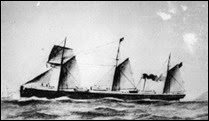| Near cyclonic storms have caused devastating damage along the East Coast of Australia.
They have been recorded ever since Cook first sailed along the East Coast of Australia in 1770.
One such “East Coast Low” in 1876 claimed the S.S. Dandenong, foundering in a storm just of Jervis Bay. Despite the courageous efforts of the Dandenong crew, and the crew of the Barque, Albert William, she disappeared during the night below huge seas, and with it, 40 poor souls crossed the veil of dark silence into the deep.
This storm became known as the “Dandenong Storm”.
Reported winds of 240k’s an hour, with 15 meter waves.
11 other vessels were lost during this storm. |
 Previous post about the S.S Dandenong. Read More. Previous post about the S.S Dandenong. Read More. |
| | Massive storm and large waves hit Jervis Bay 1974.
“I remember one such low in 1974, my relatives, and local people used sand bags to try and stop the huge seas in Jervis Bay washing away foreshore houses at Callala Beach.
“I'm not sure how many people who experienced that storm are still living, and still own houses along the foreshore, but I'm sure the new residents that live along the beach front have no idea just how close some of the houses came to being lost into the Bay”.
“There was severe damage around the foreshore of the bay, with massive seas hitting the reefs and shoreline. Callala Beach had a 10ft vertical drop just behind some of the houses, and had lost a complete sand hill that was originally in front of the houses”. | | |
The 1974 storm was known as the “Sygna Storm” Named after the 53,000-tonne Norwegian bulk carrier Sygna.
. |
 |
All ships anchored off the ports were advised to head to sea. Seven of the 10 ships anchored off Newcastle immediately did so, but Sygna remained at anchor.
By 1am the following morning, the wind had increased in strength to 165km/h and, with the huge seas and a lee shore, the captain decided to sail. He weighed anchor and the ship got under way.
He was too late. Even with her engines full-ahead, Sygna was unable to make any headway and the force of the storm turned her parallel to the beach. Within 30 minutes she was aground on Stockton Beach.
Becoming Australia’s largest wreck.
The rescue of the crew is a story of courage and daring in adverse conditions, see the link below.
REF: http://www.defence.gov.au/news/raafnews/editions/4807/history/story01.htm |
 Previous post about the S.S Dandenong. Read More.
Previous post about the S.S Dandenong. Read More.

No comments :
Post a Comment